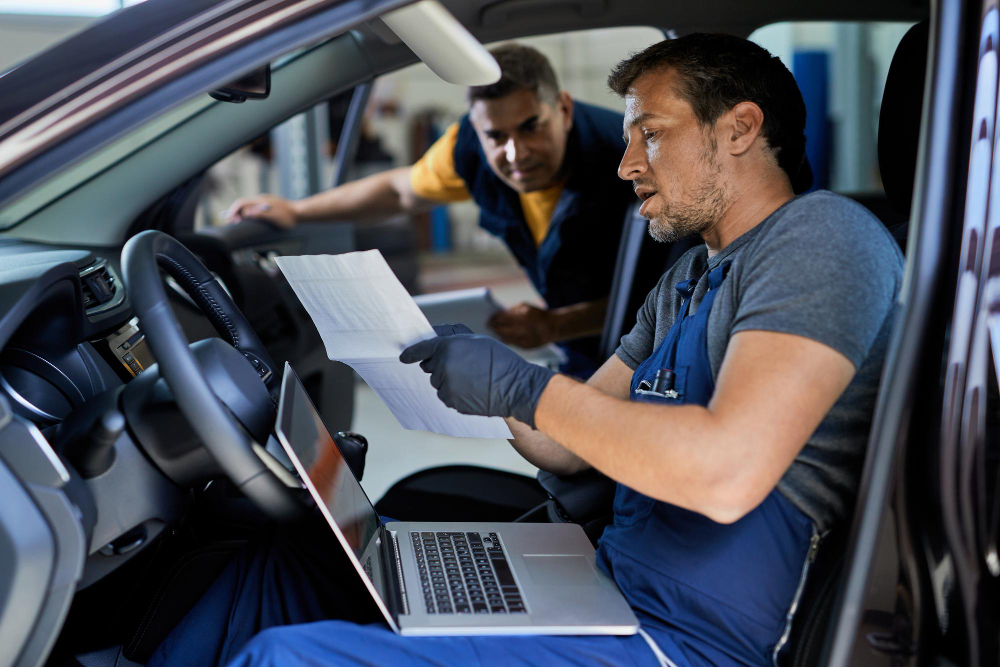The Driver Vehicle Inspection Reporting (DVIR) is one of the most important practices in the context of ensuring the safety and compliance of commercial vehicles. It is very critical in making sure that the vehicles are in viable working conditions and have no defects that may cause accidents or downtimes in the operation. We will discuss what a DVIR is and why it is important to implement a proper inspection, and how the technology is currently changing the procedure, such as the application of electronic DVIR systems.
Understanding DVIR and Its Importance
DVIR can be abbreviated as Driver Vehicle Inspection Reporting and is a standardized process to assist the commercial vehicle drivers with checking their vehicles regarding possible safety concerns either prior to, during or after travels. Drivers of commercial vehicles are required to carry out such checks according to the rules established by the Federal Motor Carrier Safety Administration (FMCSA) in order to ascertain the functional safety of the vehicle.
The main objective of the DVIR is to detect and reveal all flaws or shortcomings of the vehicle that might be life threatening. Documentation of such findings by the drivers will guarantee proper maintenance and repair of the vehicle hence making it safe to be used on the road. This not only is necessary in order to comply with the law but also enhance the general safety on the road and minimise chances of vehicle breakdowns, accidents and the high cost of repairs.
DVIR and the Fleet Management
To the fleet managers and operators, DVIR is an important tool to effective fleet management. Periodic checks and reporting would make sure that all the vehicles in the fleet are in good conditions hence reduce the chances of unforeseen breakdowns and expensive repairs. DVIR is also useful in enhancing efficiency of operations as it allows detection of maintenance requirements at an early stage hence avoiding unexpected losses.
Moreover, the proper fleet is important in keeping the reputation and satisfaction of the customers of a firm. By making sure that vehicles are regularly checked and serviced, fleet operators may guarantee that the delivery will be timely, no fines will be incurred, no accidents will happen.
The DVIR Conducting Process
A standard DVIR will entail the close examination of numerous parts of the car so as to ascertain their correct state of operation. A standard DVIR will cover some of the following areas:
1. Brakes and Lights: Review of the brake system and making sure that all the lights are on.
2. Tires: Checking condition of tires, tires depth, and adequate inflation.
3. Suspension and Steering: This involves making sure that the suspension and steering systems of the vehicle are in place.
4. Windshield Wipers and Mirrors: Checking the windshield wipers by checking that they are working as they should and checking that the mirrors are correctly adjusted.
5. Engine and Battery: Making sure that the engine is running smoothly as well as ensuring that the battery is charged.
Besides these basic checks, the driver will also check the cargo area, fuel system, exhaust system of the vehicle, as well as any other parts that may affect the vehicle performance and safety. After the inspection has been conducted, the driver will record his/her findings in a DVIR report that is later submitted to a fleet manager or a team in charge of the maintenance.
Electronic DVIR Systems
Although the use of traditional paper-based DVIRs has been the order of the day over the decades, the current technology has led to the emergence of a more efficient and streamlined process. Electronic DVIR systems have become a revolution in conducting and reporting inspections. These systems enable the drivers to do their inspections electronically without using any paper-based forms and manual data entry.
The advantages of the electronic DVIR system are many. The first one is that it makes the process of inspection more efficient as drivers can do it more rapidly. Drivers can make sure that the required reports are timely provided in real time with a possibility to record defects and issues as quickly as possible on the mobile device. This enables the fleet managers to respond to any form of maintenance or repair requirements in time hence avoiding the possibility of delays or breakdowns.
The accuracy of electronic DVIR systems is also enhanced by reducing the human error. Due to the fact that drivers can easily record their inspections through the digital forms, the possibility of dropping important details or errors is minimized. Moreover, digital records are simple to store, retrieve, and distribute and, therefore, fleet managers will find it easier to follow the history of inspection, trends, and regulations.
DVIR Meaning and regulatory Significance
As we have seen, the name DVIR is an abbreviation of Driver Vehicle Inspection Reporting. Such reporting is not a mere formality of a procedure but a statutory obligation of commercial vehicles that are registered in the FMCSA regulations. DVIR process assures compliance to safety standards in which the commercial vehicles operate, which contributes to the safety of the drivers and the people at large.
The FMCSA regulations enforce the drivers to do an inspection at the beginning of their shifts (pre-trip inspection), after the shifts (post-trip inspection), and in a few situations, during their shifts (en route inspection). The findings of the inspection have to be recorded and a report on the defects or issues should be provided. In case of any defect that is discovered to render the vehicle unsafe to drive, a repair should be done to allow the vehicle to be used again.
The inability to meet the DVIR requirements may result in penalties, fines, and even a ban on a commercial vehicle operation. Thus, the fleet operators should make sure that their drivers are educated about the necessity to carry out extensive inspections and file precise reports.
Revolutionizing DVIR Reporting
Truxup is a company that is progressing well to change the DVIR process of fleet owners in an age where technology is still playing a critical role in how businesses are conducted. The provision of a new platform where the electronic DVIR systems are incorporated eases the process of inspection and reporting, as drivers will find it easy to carry out inspections, and fleet managers can monitor the maintenance requirements of their vehicles.
The electronic DVIR solution by Truxup assists companies to have a complete digital account of the vehicle checks and provides the companies with real-time data capture and decreased administrative load. Detailed analytics are also provided on the platform, enabling fleet managers to monitor the health of vehicles, detect recurrent problems, and create a preventive maintenance plan based on it.
Furthermore, the system used by Truxup entirely follows the rules of FMCSA, which gives a sense of security to the fleet operators since their vehicles are regularly inspected and properly maintained by the law. Through Truxup, drivers are able to fill their daily inspections easily and the fleet managers instant access to the inspection reports can enhance the overall safety and performance of the fleet.
The Future of DVIR Reporting
The future of DVIR reporting is definitely online. With the further development of technologies, electronic DVIR systems will only get more advanced, being more integrated with other fleet management devices, and will allow to get a better understanding of the vehicle performance. Such functions as predictive maintenance, real-time diagnostics, and automatic alerts will make the process of keeping vehicles in order even more productive and prevent fleet operators to spend money on expensive repairs or accidents.
Furthermore, the development of artificial intelligence (AI) and machine learning (ML) may allow electronic DVIR systems to identify possible problems in the course of inspections automatically to find out the problem before it turns into a significant issue. These technologies have the potential of transforming how the inspections are undertaken and this will make the process quicker, more precise and predictive.
Conclusion
Summing up, a Driver Vehicle Inspection Report (DVIR) is a critical element of the commercial vehicle safety, which presupposes that vehicles should be in a good laborable condition and meet the requirements suggested by the regulations. Regardless of the type and method of the system, be it the traditional paper-based or electronic systems of DVIR, the aim is the same to ensure the safety and reliability of the fleet.
With the use of the most recent developments in the sphere of technologies, fleet operators will be able to optimize their workflow, increase safety, and make the process of inspection more efficient. With the industry constantly changing, the introduction of the digital tools will surely influence the future of DVIR reporting, making it more efficient, correct and compliance-based than ever before.









